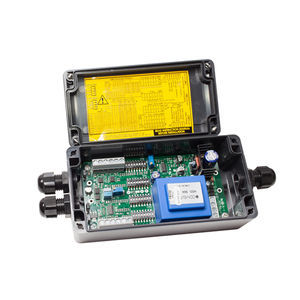
- Detection - Measurement
- Force Measurements
- LED display weight indicator
- Thames Side Sensors
- Products
- Catalogs
- News & Trends
- Exhibitions
Digital weight indicator-transmitter XT2000 LED displayDIN railEthernet

Add to favorites
Compare this product
Characteristics
- Display
- digital, LED display
- Mounting
- DIN rail
- Output
- Ethernet, Modbus, ProfiNet
- Applications
- for weighbridges
Description
The XT2000 is a high speed digital weight indicator and transmitter with a panel mount configuration. With a speed of 2400 measurements/second and several connectivity options, it is the ideal solution for a very wide range of weighing applications both static and dynamic.
Standard connections: 3 digital opto-isolated inputs, 3 digital opto-isolated outputs (all with status LEDs), serial RS232, serial RS485, MODBUS (RTU or ASCII).
Optional connections in addition to the above: Analogue outputs (e.g. 4-20mA) or Profibus® DP or PROFINET I/O or EtherNet/IPTM.
Designed for process weighing systems, as well as any machinery with a weighing function, it incorporates the latest digital electronics. The instrument status is easily viewed using the 6-digit bright red LED display (10mm height) and status LEDs for tare, prefixed tare, zero and steady weight.
The XT1000 has OIML R76 and EN 45501:2015 approvals.
Calibration can be achieved by using live weights, or with the load cell capacity and sensitivity data in mV/V allowing for fast start-up without live weights.
For an Omega/DIN rail version with the same specification, see the XT1000 indicator and transmitter.
Typical applications:
• Industrial weighing scales
• Weighing and level measurement of tanks and silos
• Transmission of weight to a PLC
• Filling and dosing machines
• Checkweighers
• Animal weighing
• High speed sorting scales
• Multihead weighers
• Crane / lifting equipment overload control
Catalogs
No catalogs are available for this product.
See all of Thames Side Sensors‘s catalogsRelated Searches
- Force sensor
- Tension/compression force sensor
- Steel force transducer
- Strain gauge force transducer
- Stainless steel force sensor
- Weighing force sensor
- Beam type force transducer
- Compression force sensor
- Weighing terminal
- Digital weighing terminal
- IP67 force transducer
- Aluminum force sensor
- IP68 force sensor
- Shear beam load cell
- OIML load cell
- Analog force sensor
- Off-center load cell
- High-precision force sensor
- IP code weight indicator
- Hopper resistive load cell
*Prices are pre-tax. They exclude delivery charges and customs duties and do not include additional charges for installation or activation options. Prices are indicative only and may vary by country, with changes to the cost of raw materials and exchange rates.




